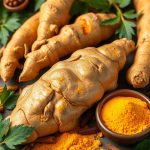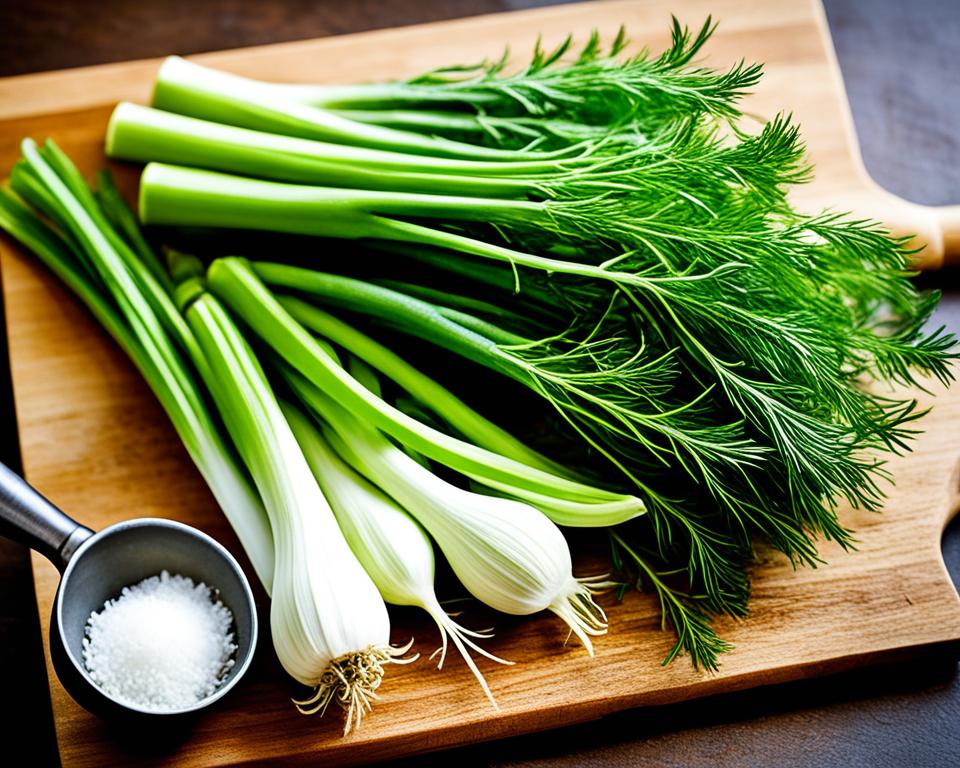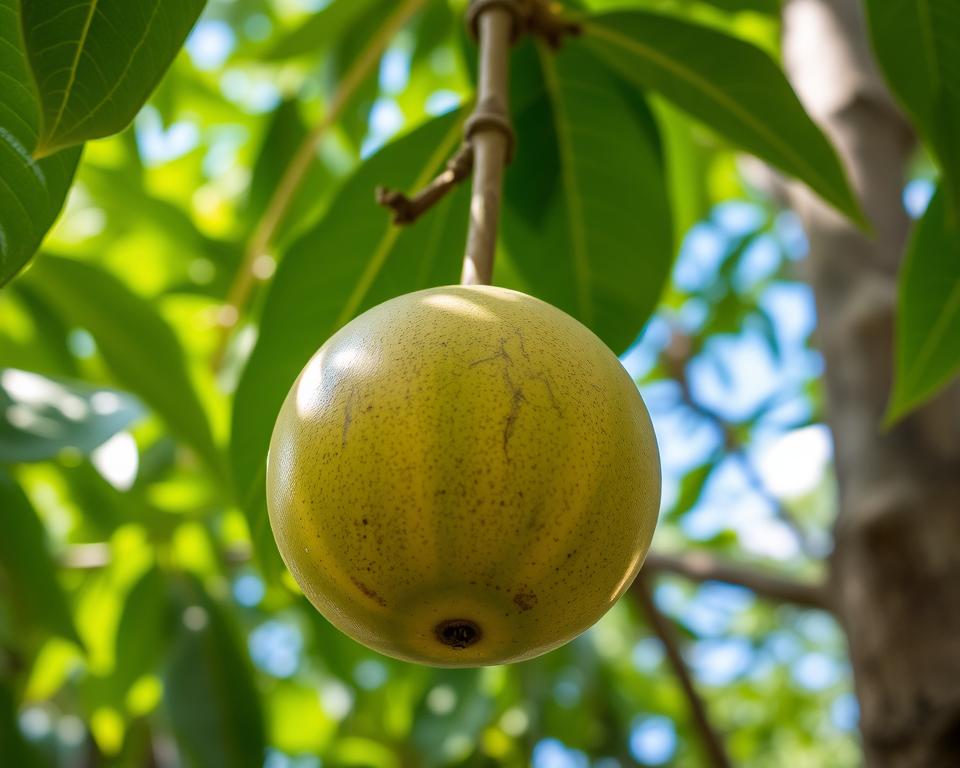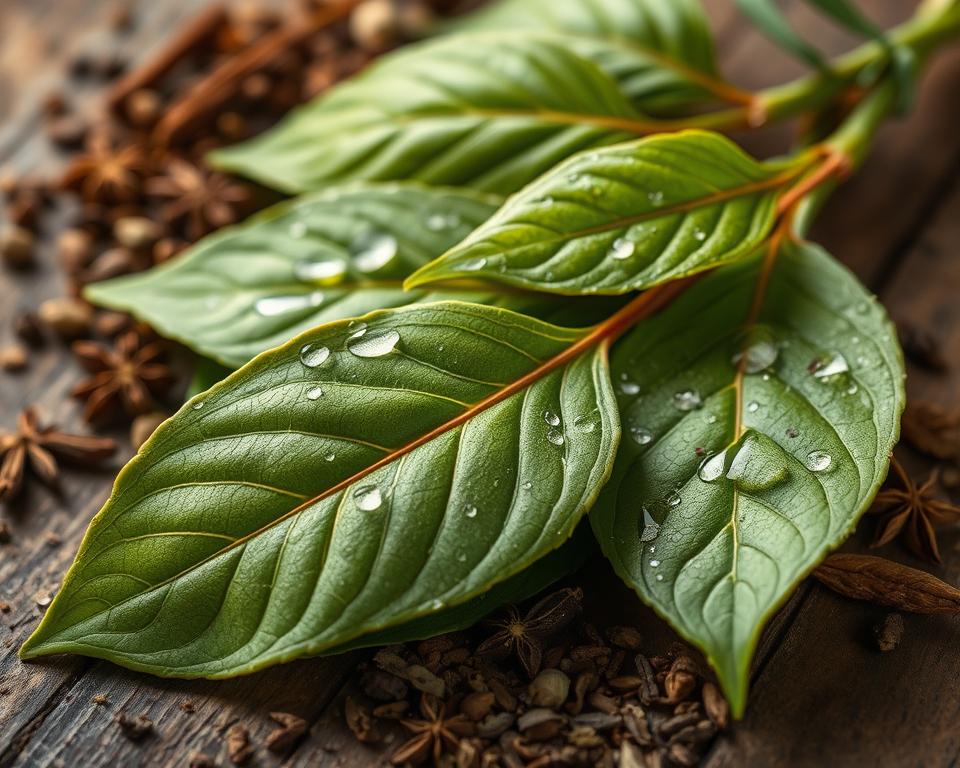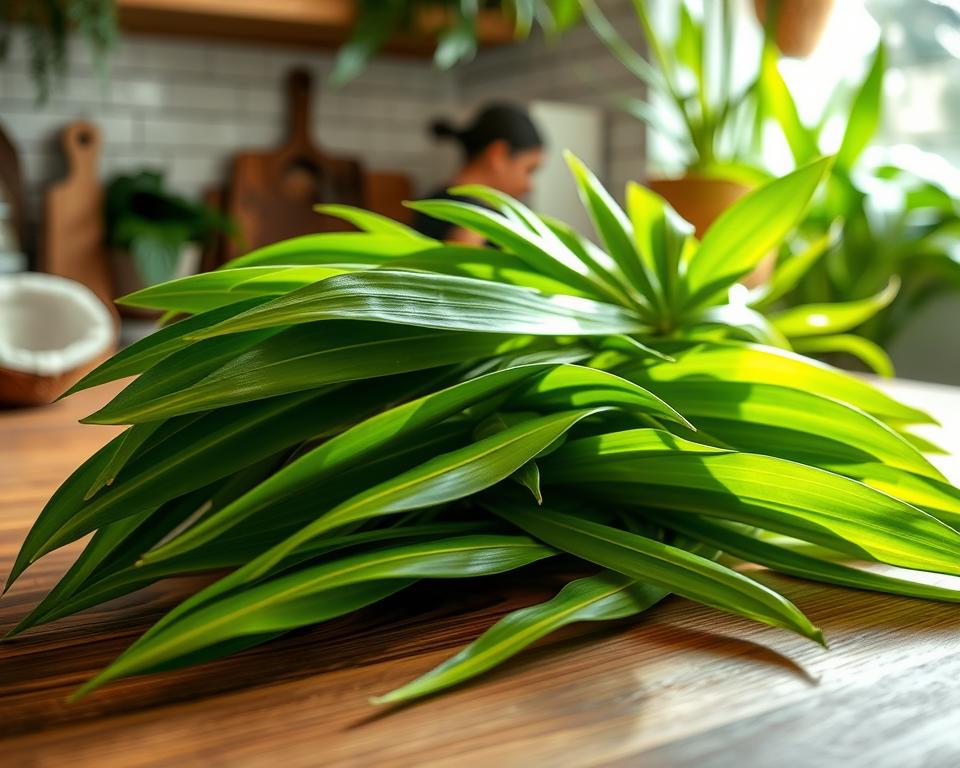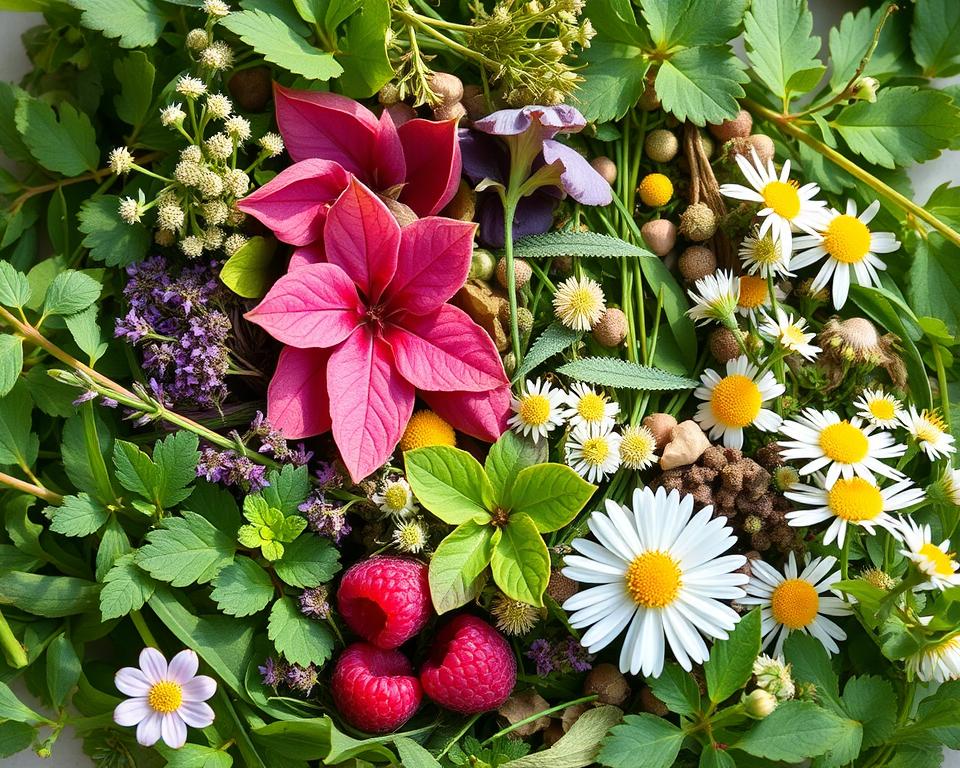Fennel is a key part of the carrot family, loved for its many uses in cooking and health. It has a special flavor that tastes like licorice. Chefs and home cooks love it for its crunchy bulbs, tasty fronds, and strong seeds. These parts make many dishes better, both salty and sweet.
But fennel is more than just for cooking. Its seeds and essential oil are great for health. They help with digestion, boost antioxidants, and add a special touch to food. So, fennel is a must-have in every kitchen.
Read interesting things at : tosawakan
Key Takeaways
- Fennel is a versatile herb with a wide range of culinary and health benefits.
- The plant’s edible parts include the bulb, fronds, and seeds, each with unique flavors and applications.
- Fennel seeds and essential oil are prized for their medicinal properties, such as aiding digestion and providing antioxidant protection.
- Fennel can be easily incorporated into both savory and sweet dishes, adding a touch of licorice-like aroma and flavor.
- Growing fennel at home is a rewarding experience, allowing you to enjoy the fresh, fragrant herb year-round.
What is Fennel?
Fennel, known as Foeniculum vulgare, is a special plant in the carrot family. It has been grown for centuries for its taste and health benefits. Learning about fennel’s types helps us use it in many ways in cooking and beyond.
Botanical Overview
The fennel plant grows up to 2.5 meters tall and has feathery leaves. It also has yellow flowers that grow in umbels. The bulbous base is the most known part, often eaten in many dishes.
Varieties and Cultivars
Fennel comes in many types, each with its own taste and use. Some common ones are:
- Florence Fennel: Known as “Finnochio,” it has a big, crisp bulb great for Mediterranean dishes.
- Sweet Fennel: Grown for its seeds, which are used in spices and drinks.
- Bronze Fennel: This has bronze-colored leaves and is often used in gardens for looks.
- Purplette Fennel: It has a deep purple color and tastes slightly sweeter than others.
These different types of fennel make it useful in cooking and as a plant in gardens.
| Fennel Variety | Characteristics | Culinary Uses |
|---|---|---|
| Florence Fennel | Large, crisp bulb | Used in Mediterranean dishes, often roasted or braised |
| Sweet Fennel | Aromatic seeds | Utilized in spice blends, liqueurs, and baked goods |
| Bronze Fennel | Vibrant bronze-colored foliage | Primarily used as an ornamental plant in gardens and landscapes |
| Purplette Fennel | Vibrant purple hue and slightly sweeter flavor | Versatile in both culinary and decorative applications |
Culinary Uses of Fennel
Fennel has a unique licorice-like taste that makes it great for many dishes. It can be used in both savory and sweet recipes. Each part of the fennel plant has its own uses in the kitchen.
The fennel bulb is often used in cooking. You can slice it and add it to salads, roast it, or sauté it as a side. Its crunchy texture and mild taste are perfect for soups, stews, and braises.
In Italian and Mediterranean cooking, fennel bulb is a favorite. It goes well with seafood or can be the base for sauces and pestos.
The fennel fronds, or the feathery green leaves, are also useful. They add flavor as an aromatic herb. They’re often used as a garnish for fish, meat, or vegetables. Or, they can be chopped and added to sauces, dips, and dressings.
Fennel seeds have a strong licorice taste. They’re great in savory dishes like sausages, curries, and braises. You can also grind them into a powder for seasoning or in baked goods like breads and pastries.
“Fennel is a versatile ingredient that can be used in both sweet and savory dishes, adding a unique flavor profile that complements a wide range of ingredients.”
Fennel is also used in making certain liquors, like absinthe and ouzo. Its distinct flavor is a key part of these drinks.
Whether you’re making a savory meal or a sweet dessert, fennel can add something special. Its versatility and unique taste make it a valuable ingredient for any cook.
Fennel Seeds and Their Uses
Fennel seeds come from the fennel plant and are very useful in cooking and medicine. They have been used for hundreds of years in many cuisines and healing traditions worldwide.
Culinary Applications
Fennel seeds are loved for their unique licorice-like taste. You can use them whole or ground to make dishes more interesting. Here are some ways to use fennel seeds in cooking:
- Season meats, stews, and roasted veggies
- Add flavor to breads, crackers, and baked treats
- Make sauces, marinades, and dressings smell great
- Add a subtle taste to pickles, relishes, and condiments
Fennel seeds can be used in both sweet and savory dishes. They are a great addition to any spice collection.
Medicinal Properties
Fennel seeds are also known for their health benefits. In Ayurveda and Traditional Chinese Medicine, they have been used for a long time. Some of their health benefits include:
- Helping with digestion by soothing the stomach and reducing bloating
- Being full of antioxidants that help overall health
- Offering relief for coughs and stuffy noses
- Having antimicrobial properties to keep the gut healthy
More studies are needed to know how much fennel seeds can help with health. But, their long use in traditional medicine and new research suggest they could be very beneficial.
“Fennel seeds have been a staple in many traditional healing practices for their versatile properties and ability to promote overall well-being.”
Fennel Bulb: A Versatile Vegetable
The fennel bulb belongs to the Apiaceae family. It’s a versatile vegetable that adds a unique flavor to many dishes. Its licorice-like aroma and crisp texture make it a favorite in kitchens worldwide.
Preparation and Cooking Methods
Getting ready to use the fennel bulb is easy. First, trim off the stems and fronds, saving them for later. Then, slice the bulb in a way that suits your dish and cooking method. You can enjoy it raw in salads or cook it to bring out its best flavors.
- Roasting: Cut the fennel into wedges or slices. Drizzle with olive oil, season with salt and pepper. Roast until tender and golden.
- Sautéing: Sauté sliced or diced fennel in butter or oil until it’s soft and fragrant.
- Braising: Simmer the fennel in broth, wine, or other liquids until tender. The liquid will reduce into a tasty sauce.
- Grilling: Grill fennel slices or wedges for a smoky flavor, alone or with other veggies.
The fennel bulb fits into many dishes, from soups to pasta. It’s especially good with seafood, poultry, and certain herbs and spices.
| Cooking Method | Preparation Tips | Ideal Flavor Pairings |
|---|---|---|
| Roasting | Cut into wedges or slices, toss with oil, salt, and pepper | Herbs (e.g., thyme, rosemary), citrus, parmesan |
| Sautéing | Slice or dice the bulb, cook in butter or oil until tender | Garlic, onions, white wine, lemon |
| Braising | Place bulb in pot with broth, wine, or other liquid, simmer until tender | Chicken or vegetable broth, white wine, tomatoes |
| Grilling | Cut into slices or wedges, brush with oil or marinade | Lemon, herbs, spices (e.g., cumin, coriander) |
Exploring different ways to prepare and cook the fennel bulb opens up new culinary possibilities. It makes adding this versatile vegetable to your meals easy and exciting.
Fennel Fronds and Their Uses
The fennel bulb and seeds are well-known for their taste and health perks. But, the feathery fennel fronds are often ignored. These green leaves are both versatile and tasty, making many dishes better.
Fennel fronds taste like anise but are milder and fresher than the bulb and seeds. They add flavor and look to many dishes.
Culinary Applications of Fennel Fronds
Fennel fronds work well in both cooked and raw dishes. They bring a unique flavor and texture. Here are some ways to use them:
- Garnishing salads, soups, and seafood for freshness and crunch
- Adding to pesto or chimichurri sauces for herbal flavor
- Putting them on roasted veggies, grilled meats, or pasta for flavor
- Using in omelets, quiches, or frittatas for a soft, aromatic touch
- Mixing into syrups, vinegars, or oils for unique ingredients
Fennel fronds are soft and feathery, perfect as a garnish. They add freshness and beauty to dishes. Their bright green color brightens up any plate, making them a favorite among chefs and cooks.
Looking to add flavor or elegance to your dishes? Fennel fronds are a great, underused ingredient to try.
Fennel Tea and Its Benefits
Fennel tea is a soothing drink made from the seeds or parts of the fennel plant. It’s known for its health benefits, making it great for wellness routines.
This tea is full of good compounds like anethole, fenchone, and estragole. These help with digestion and offer antioxidant support.
Potential Health Benefits of Fennel Tea
- Supports Digestive Health: Fennel tea helps with bloating, gas, and indigestion. Its oils boost digestive juices and relax the gut muscles.
- Reduces Menstrual Discomfort: It might ease menstrual cramps and other cycle discomforts with its anti-inflammatory effects.
- Promotes Respiratory Health: Fennel tea could clear congestion and soothe breathing problems.
- Provides Antioxidant Protection: Fennel’s antioxidants fight off harmful free radicals for better health.
Adding fennel tea to your daily routine is easy and enjoyable. Enjoy it hot or iced to boost your wellness.
| Nutrient | Amount per Cup of Fennel Tea |
|---|---|
| Calories | 0 |
| Carbohydrates | 0 g |
| Protein | 0 g |
| Fat | 0 g |
| Fiber | 0 g |
| Vitamin C | 1.2 mg |
| Calcium | 11 mg |
| Iron | 0.4 mg |
The table shows what’s in a cup of fennel tea. It’s low in calories but packed with nutrients. Drinking this tea is a great way to support your health.
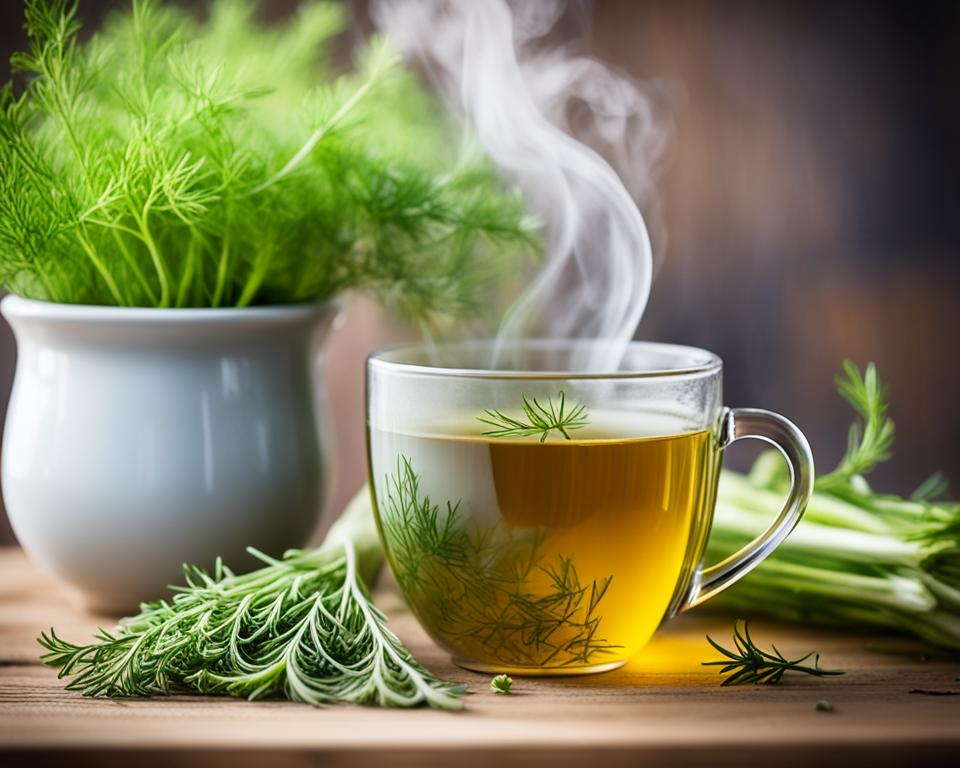
“Fennel tea is a delightful and versatile beverage that can offer a range of potential health benefits. From aiding digestion to providing antioxidant support, this aromatic tea is a wonderful addition to any wellness routine.”
Fennel Essential Oil
Fennel is known for its flavor and health benefits. It also gives us a special essential oil. This oil comes from the fennel plant’s seeds. It smells like licorice and is used in many wellness practices.
Extraction and Uses
To make fennel essential oil, steam distillation is used. This method keeps the oil’s natural benefits. It’s popular in aromatherapy and personal care.
Fennel essential oil is great for calming the mind and body. It can ease stress, anxiety, and tiredness. It also helps with digestion by reducing bloating and gas.
Fennel essential oil is used in many personal care products. It’s good for the skin and can be found in natural deodorants and skincare. Its antibacterial and anti-inflammatory properties are useful.
Fennel oil is also good for the lungs. It can clear the airways and ease congestion. This makes it a natural remedy for colds and breathing problems.
Fennel essential oil is versatile and important in natural wellness. Its unique benefits and uses make it a top choice for those looking to improve their health naturally.
Health Benefits of Fennel
Fennel is a versatile herb with a unique licorice-like taste. It’s packed with potential health benefits. It helps with digestion and offers antioxidant protection. This aromatic plant is now a favorite in health-focused diets.
Digestive Health
Fennel seeds are famous for their digestive benefits. They’ve been used for centuries to ease stomach problems. Fennel’s fiber and compounds like anethole help with digestion. They also have anti-inflammatory and spasmolytic properties. Eating fennel can ease stomach pain, reduce bloating, and help with regularity.
Antioxidant Properties
Fennel is also known for its antioxidants. It’s full of phytochemicals like flavonoids and phenolic compounds. These antioxidants fight off harmful free radicals. This can lower the risk of chronic diseases.
Studies show fennel’s antioxidants may protect against cardiovascular disease, cancer, and neurodegenerative disorders. Its vitamin C content boosts its antioxidant effects. This makes fennel a great choice for a healthy diet.
“Fennel is a treasure trove of essential nutrients and bioactive compounds that have the potential to promote overall well-being.”
Adding fennel to your meals and wellness routines can be beneficial. You can enjoy the crunchy bulb, drink fennel tea, or add seeds to your dishes. Fennel is a natural way to support your digestive health and get antioxidants.
Growing Fennel at Home
Fennel has a unique taste like licorice and is easy to grow at home. It’s great for both experienced and new gardeners. Growing your own fennel lets you enjoy its fresh taste and flavor.
Site Selection and Soil Preparation
Fennel does well in soil that drains well and is full of nutrients. Pick a spot in your garden that gets at least six hours of sunlight a day. Before planting, add compost or manure to the soil to make it richer and improve drainage.
Planting and Caring for Fennel
- Sow fennel seeds in the spring or early summer when the soil is warm.
- Plant the seeds 12-18 inches apart and cover them with a thin layer of soil.
- Keep the soil moist but not too wet.
- Thin the plants as they grow to give them enough room.
- Use mulch around the plants to keep the soil moist and control weeds.
- Pick the fennel bulbs when they are 3-4 inches wide, about 12-16 weeks after planting.
Tip: For a steady supply of fennel, plant seeds every 2-3 weeks during the growing season.
Harvesting and Storing Fennel
You can pick fennel in stages, using the bulbs, fronds, and seeds. Pull or cut the bulbs carefully, leaving the roots intact. Cut the fronds as needed, and collect the seeds when the flowers dry out.
Keep harvested fennel fresh in the fridge, wrapped in a damp paper towel or in a bag with holes. You can also freeze or dry fennel for later use.
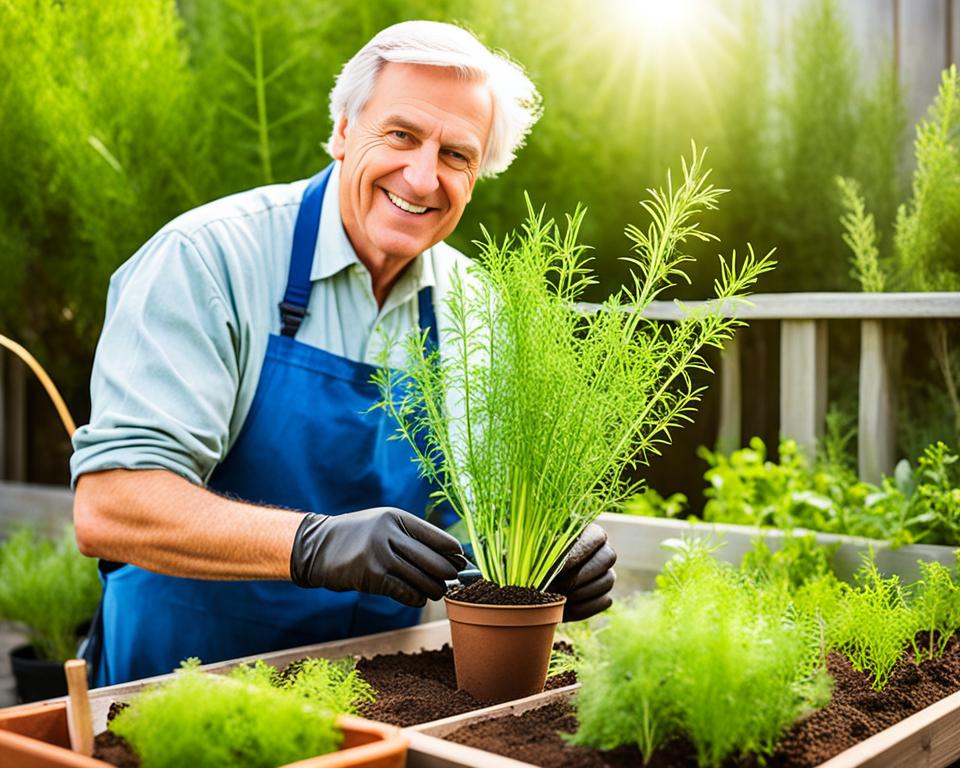
Growing fennel at home is rewarding and lets you enjoy its many uses. With these easy steps, you can grow your own fennel. Then, use it in many dishes for flavor and health benefits.
Incorporating Fennel into Your Diet
Fennel is a versatile herb that can be used in many dishes. It goes well in savory main courses and sweet desserts. The unique flavor and texture of fennel can make your meals special. Here are some tasty ways to add fennel to your cooking.
Delicious Fennel Recipes
Roasting fennel is a popular way to use it. Slice the bulb, mix with olive oil, salt, and pepper. Then, roast it until it’s tender and caramelized. This dish is great as a side or a base for other recipes.
For a heartier dish, try fennel and sausage pasta. Sauté sliced fennel with Italian sausage, then add your favorite pasta and a creamy sauce. The fennel adds a sweet anise flavor that goes well with the sausage.
- Fennel and Citrus Salad: Shave thin slices of raw fennel and mix with fresh orange or grapefruit, olive oil, salt, and pepper.
- Fennel Gratin: Layer sliced fennel with cheese, breadcrumbs, and béchamel sauce, then bake until golden and bubbly.
- Fennel and Apple Slaw: Grate or slice fennel and apples, mix with a tangy vinaigrette for a refreshing slaw.
For a sweet dish, use fennel fronds in a cake or fennel seeds in biscotti. The licorice-like flavor of fennel is great with both sweet and savory foods.
| Fennel Recipe | Key Ingredients | Preparation |
|---|---|---|
| Roasted Fennel | Fennel bulb, olive oil, salt, pepper | Slice fennel, toss with oil, salt, and pepper, then roast at 400°F until tender and caramelized. |
| Fennel and Sausage Pasta | Fennel bulb, Italian sausage, pasta, creamy sauce | Sauté sliced fennel with sausage, then toss with cooked pasta and a creamy sauce. |
| Fennel and Citrus Salad | Fennel bulb, oranges or grapefruits, olive oil | Shave thin slices of raw fennel and mix with citrus segments and olive oil. |
Fennel is versatile and can be added to many dishes. Try different parts of the plant to explore its unique flavor and texture. Add fennel to your meals for a special touch.
Fennel in Cultural Traditions
Fennel is more than just a spice; it’s a key part of many cultures and folklore. Its long history shows how much people value this herb. It’s a symbol of tradition and appreciation.
The fennel cultural traditions go way back to ancient times. In ancient Greece, people thought Prometheus brought fennel to Earth, making it special. The Romans also saw it as important, using it in religious events.
But fennel’s uses weren’t just for cooking. In traditional Chinese medicine, its seeds helped with digestion and breathing. In Ayurvedic medicine, fennel was used to make remedies for health.
The stories about fennel are just as interesting. Some believed it could keep away bad spirits, so it was in charms. In Europe, people put fennel in their homes during the summer solstice to honor the sun.
Today, fennel still holds a special place in our lives. It’s used in many traditional dishes and is part of stories and rituals. This herb connects us to our past and the stories that make us who we are.
Conclusion
We’ve taken a deep dive into the world of fennel, a versatile herb with many uses. It’s not just for cooking; it’s also good for our health and has cultural significance. This plant is truly remarkable and should be a key part of our lives.
We’ve seen how fennel adds flavor to many dishes, from savory to sweet. It’s not just about taste, though. Fennel is also great for our health, helping with digestion and being full of antioxidants.
As we wrap up, it’s clear that fennel is an amazing herb. It’s perfect for anyone who loves cooking, values health, or wants to try new foods. Adding fennel to your life opens up a world of tasty and healthy options. With its versatile uses and numerous health benefits, fennel is ready to make your meals better and support your well-being.





